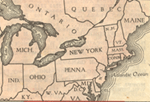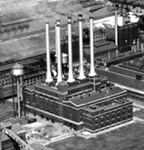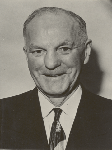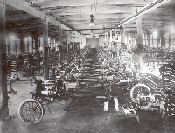
From Motor City to Motor Metropolis: How the Automobile Industry Reshaped Urban America
Becoming the Motor City: Immigrants, Migrants, and the Auto Industry
Detroit rose and fell with the automobile industry. Before the invention of the motorized, self-propelled auto car, Detroit was a second-tier industrial city with a diverse, largely regional manufacturing base. The thirteenth largest city in the United States in 1900 with 285,000 residents, Detroit was compact. Most of its population lived within a few mile radius of downtown. As in the case of most nineteenth-century industrial cities, its manufacturing clustered along the river, whose water provided power and easy transportation for incoming supplies and outgoing goods. No one industry dominated. Leading Detroit industries included stove manufacture, tobacco goods, drugs and chemicals, metal working, and food production. At the turn of the twentieth century, the manufacture of motor vehicles was among the city's growing--but still relatively small--industrial concerns. Over the next thirty years, the auto industry took off. By the onset of the Great Depression, car manufacturing completely dwarfed manufacturing concerns in Detroit. And so many more of the city's companies were somehow related to the auto industry, from machine tool manufacturers to auto supply companies to parts suppliers. The rise of the auto industry utterly transformed Detroit, attracting over a million new migrants to the city and, both through its demographic and its technological impact, reshaping the cityscape in enduring ways.
Detroit was ideally situated to be a center of the American automobile industry. Detroit was in the center of America's industrial heartland--a region that extended like a belt from lower New England down to Pennsylvania and across the Appalachians westward through Ohio, Indiana, and Illinois. All of the raw materials needed for automobile production were easily accessible to the city by the Great Lakes waterways and by rail. The coal regions of mountainous Pennsylvania and West Virginia were no more than a day away by rail. The great steel mills of Pittsburgh, Youngstown, Cleveland, Gary, and Chicago were all within a few hundred miles of the city. The iron and copper ore regions of northern Michigan and Minnesota were easily accessible by ship. At the confluence of east and midwest, Detroit's central location gave its auto producers easy access to the capital and markets necessary for its phenomenal growth.
Detroit's first auto plants were small operations, but as Ford pioneered the techniques of mass production at the new Highland Park Plant, with its cutting-edge assembly line techniques, the scope and scale of auto production grew accordingly. By the 1920s, Dodge had built the enormous Main Plant in Hamtramck, just a short distance from Ford's pioneering Highland Park facility. But by far the most ambitious and landscape-altering plant was Ford's vast River Rouge complex. Finished in 1927, the River Rouge plant consisted of nineteen separate buildings in a vast industrial complex that sprawled over more than two square miles. The River Rouge plant was a wholly self-contained center of production. It included a man-made deep sea harbor, the world's largest steel foundry, ninety-four miles of railroad track, and stamping, glass making, and auto assembly buildings, among many others. At its peak, over 90,000 workers toiled at the Rouge. The looming plant became an international phenomenon, visited and photographed by thousands of international visitors, the subject of film reels celebrating American industrial might, and an important model for the industrialization of the Soviet Union.
Right from the outset, the automobile industry was labor-hungry. Aspiring auto workers flooded into the city from the rural hinterlands of the midwest, which provided a ready supply of workers who had been displaced by the decline of the logging industry and the travails of small farming. One such newcomer was James O'Connor. As soon as he finished grammar school in rural Emmett, Michigan, about sixty miles north of Detroit, O'Connor headed south to Detroit, eventually taking a job at Ford in 1907, when he was only 19. Many new autoworkers hailed from Canada--which by 1910 had become the leading source of immigration to the Motor City. Increasingly, auto manufacturers cast their nets more widely. Ford led the way. His firm recruited skilled workers from the industrial cities of England and Scotland. Ever eager to find new sources of labor, Ford extended his firm's recruiting networks abroad, to places as far afield as Mexico and the Middle East.
Word of mouth was at least as powerful a recruiting tool. Stories of the seemingly bottomless economic opportunity in Detroit--particularly after Ford announced that he would pay workers $5.00 per day in 1914--drew many thousands more workers to the city. Mexican immigrants, many of whom had come to the United States as farmworkers, sought greater opportunities in what they called the "wonderful city of the magic motor." Many German metal and wood workers found a new use for their refined skills in the tool and die and machine shops that ringed the city. And many lesser skilled workers came from places as far flung as Warsaw, Dublin, Budapest, and Hamburg and countless villages and towns in central and eastern Europe with hopes of getting jobs that required little education or training on the new assembly lines. Many new immigrants, like Tony Leszczynski who immigrated from Poland, reached the United States and headed straight to Detroit to work in the auto industry.
<<Previous Section - Next Section>>
Becoming the Motor City: Immigrants, Migrants, and the Auto Industry
Living in the Motor City: Autoworkers, Race, and Urban Geography
Building the Motor Metropolis: Automobiles, Highways, and Sprawl
Moving Out: Decentralization and the Decline of Urban Factories
Downsizing: Depopulation, Disinvestment, and the Fate of the City
Complete Text Printable View
America's industrial heartland
Ford Motor Company's River Rouge Plant
Ford Motor Company's Piquette Plant
About the Project | Credits | Contact Us | Student & Teacher Resources | Site Map
©2004 Automobile in American Life and Society





